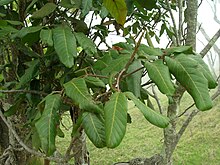| Alectryon macrococcus | |
|---|---|

| |
| A. m. var. auwahiensis | |
| Conservation status | |
 Critically Endangered (IUCN 3.1) | |
| Scientific classification | |
| Kingdom: | Plantae |
| Clade: | Tracheophytes |
| Clade: | Angiosperms |
| Clade: | Eudicots |
| Clade: | Rosids |
| Order: | Sapindales |
| Family: | Sapindaceae |
| Genus: | Alectryon |
| Species: | A. macrococcus |
| Binomial name | |
| Alectryon macrococcus Radlk. | |
Alectryon macrococcus, known as ʻAlaʻalahua or Māhoe in Hawaiian, is a slow-growing flowering tree in the soapberry family, Sapindaceae, that is endemic but manifests rarely in mesic forests of Kauai, Oahu, Molokai, and Maui Hawaii. The tree grows to a maximal height of about 10 meters with leaves 3 to 30 cm long with two to five pairs of elliptic pinnae. The pinnae are smooth, glossy and net-veined, 4 to 10 inches long and 2 to 5 inches. Fruits are from 1 to 3 inches in diameter with a single black seed embedded in a red, fleshy aril.
Their leaves are each made up of oval-shaped, asymmetrical, net-veined leaflets. Variety auwahiensis has leaflets with rusty-red undersides. The fruits contain a seed with a bright red aril. More than a century ago, it was noted that Native Hawaiians ate the fleshy, insipid and slightly sweet arils and mildly flavored seeds.native Hawaiians. The seeds also attract rats, whose consumption of them prevents the plants of this endangered species from reproducing. The black twig borer (Xylosandrus compactus) destroys the twigs.
Alectryon macrococcus var. auwahiensis has been found growing naturally only (endemic) in Maui, where it grows in Hawaiian tropical dry forests on the south slope of Haleakalā at elevations of 360–1,070 m (1,180–3,510 ft). It is threatened by habitat loss.
Alectryon macrococcus var. macrococcus inhabits mesic forests at elevations of 365–1,035 m (1,200–3,400 ft) on Kauaʻi, Oʻahu, Molokaʻi and western Maui.
References
- Bruegmann, M.M.; Caraway, V. (2003). "Alectryon macrococcus". IUCN Red List of Threatened Species. 2003: e.T44144A10863892. doi:10.2305/IUCN.UK.2003.RLTS.T44144A10863892.en. Retrieved 12 November 2021.
- Wagner, Warren L.; Herbst, Derral R.; Sohmer, S. H. (1999). Manual of the flowering plants of Hawai'i. Honolulu: Univ. of Hawaii Press. ISBN 9780824821661.
- Donald R. Hodel (2015). "Trees in the Landscape, Part 11: Alectryon excelsus subsp. excelsus" (PDF). PalmArbor. 2015 (1): 1–13.
- ^ "Alectryon macrococcus var. auwahiensis". CPC National Collection Plant Profile. Center for Plant Conservation. Archived from the original on 2010-10-28. Retrieved 14 Dec 2013.
- Joseph Rock (1974). The indigenous trees of the Hawaiian Islands. Lawai, Hawaii: Pacific Tropical Botanical Garden. ISBN 0804811407.
- "Comprehensive Report Species - Alectryon macrococcus". The Nature Conservancy. Retrieved 14 Dec 2013.
- Bruegmann, M.M.; Caraway, V. (2003). "Alectryon macrococcus var. auwahiensis". IUCN Red List of Threatened Species. 2003: e.T33574A9794168. doi:10.2305/IUCN.UK.2003.RLTS.T33574A9794168.en. Retrieved 12 November 2021.
- "ʻAlaʻalahua, mahoe; Alectryon macrococcus var. auwahiensis" (PDF). Comprehensive Wildlife Conservation Strategy. State of Hawaiʻi. Archived from the original (PDF) on 2013-11-03. Retrieved 14 Dec 2013.
- ^ Linney, G. (1987). "Nomenclatural and taxonomic changes in Hawaiian Alectryon (Sapindaceae)". Pacific Science. 41 (1–4): 68–73. hdl:10125/1021.
- ^ St John, H.; Frederick, L. (1949). "A Second Hawaiian Species of Alectryon (Sapindaceae): Hawaiian Plant Studies 17". Pacific Science. 3 (4): 296–301. hdl:10125/8938.
- Bruegmann, M.M.; Caraway, V. (2003). "Alectryon macrococcus var. macrococcus". IUCN Red List of Threatened Species. 2003: e.T34045A9834010. doi:10.2305/IUCN.UK.2003.RLTS.T34045A9834010.en. Retrieved 12 November 2021.
- "Taxon Summary: Alectryon macrococcus var. macrococcus" (PDF). Final Implementation Plan for Mākua Military Reservation, Island of Oʻahu. University of Hawaii at Manoa. Retrieved 14 Dec 2013.
External links
[REDACTED] Media related to Alectryon macrococcus at Wikimedia Commons
This Sapindales-related article is a stub. You can help Misplaced Pages by expanding it. |
This rosid tree article is a stub. You can help Misplaced Pages by expanding it. |